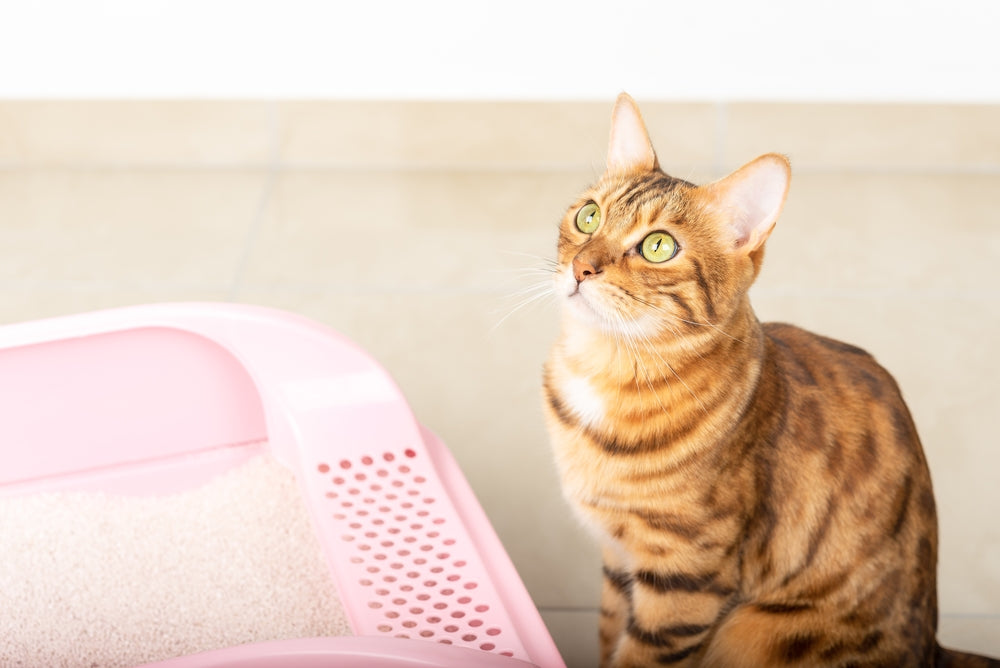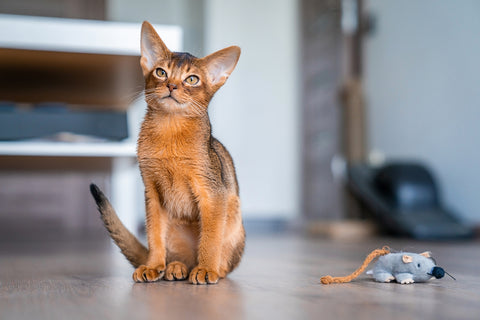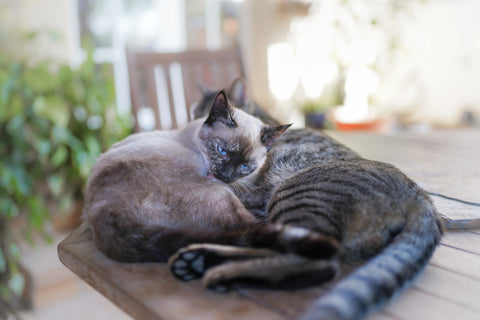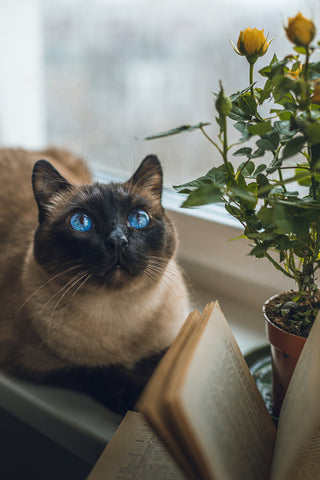
As cat parents, we strive to provide our fur babies with the very best care possible. Whether we find it unpleasant or not, your cat's poop is an insightful indicator of their overall health and well-being. If you know what to look out for, your cat's poop can help you recognize key signs of potential health problems and when it's time to see your veterinarian. This blog will help you get acquainted with healthy cat poop and teach you the signs to look out for the next time you're cleaning your cat's litter box. Let's talk about cat poop!
Understanding Your Cat's Poop
How Often Should My Cat Poop?
The general rule of thumb is that a cat should poop at least once a day. However, the frequency of your cat's bowel movements can be affected by different factors, including age (kittens poop more often than adults), diet, exercise levels, and underlying health conditions such as inflammatory bowel disease (IBD), hyperthyroidism, parasites, or chronic kidney disease (CKD).
The exact frequency of bowel movements vary from one cat to another, so it's important to get to know your own cat and monitor them for changes in frequency on a daily and weekly basis. If your cat's bowel movements start to differ from their normal frequency for longer than a day or two, you should consult your veterinarian for advice.
What Does Healthy Cat Poop Look Like?
Healthy cat poop should be deep brown in color. It's consistency should be similar to modeling clay, not too hard and not too soft. It should be firm enough to leave little to no residue on the ground when picked up, yet still pliable. Poop should be long-shaped with a segmented appearance, ideally passed in one long piece with only a few smaller pieces potentially accompanying the longer piece. The odor shouldn't be too foul, though this can also vary from cat to cat and change with diet.
Monitor your cat's poop for consistency, shape, and color. Consistency is directly influenced by the amount of moisture in the poop, which provides insight into the health of your cat's colon (aka large intestine). The colon reabsorbs any water and other key nutrients that remains from indigestible food or other material, such as cat grass. This reabsorption process helps solidify waste material into firm poop.
What Does Unhealthy Cat Poop Look Like?
Cat poop color is one way that can help you track what's going on with the health of your cat. If you notice red coloring in your cat's poop, this can be an indicator of bleeding in their anus or rectum. Poop that is orange in color is often a sign of problems with your cat's liver or gallbladder. Black stools signal internal bleeding in the gastrointestinal (GI) tract, and may occur in combination with vomiting, weight loss, changes in appetite, and lethargy. If your cat's poop is any of these colors, especially black or orange, it is very important to contact your veterinarian immediately. If bleeding from the anus that may be causing your cat's poop to be red in color does not resolve in a couple of days, it is also important to contact your vet. This is because external bleeding can be caused by a bacterial infection, or by other conditions such as the highly contagious feline distemper virus, also known as feline panleukopenia.
Poop that is too hard or too runny and soft can also be an indicator of a potential health issue. In the next section, we dive more deeply into the consistency of your cat's poop that you can track with a "fecal scoring" chart.
Fecal (Poop) Scoring
Purina Veterinary Diets provides a comprehensive fecal scoring guide, shown below, which scores the consistency of a cat's poop on the scale from 1 to 7. Healthy stool is scored with 2, while the stool that is too hard and dry is scored with 1. Scores from 3 to 7 are reserved for moist, mushy or liquid stools.

Constipation and Diarrhea in Cats
Hard stool is typically a sign of constipation, and has a score of 1. This type of poop can be associated with dehydration, obesity, hairballs, and/or colon obstruction. If you notice that your cat is passing poop that is too hard in consistency for more than 48 hours, you should pay a visit to the vet and address the issue. Poop that too hard in consistency is passed in smaller, more spherical pellets that are more difficult for a cat to pass and typically leave no noticeable residue.
Soft, mushy or liquid stools (scores 3-7) can be a sign of bacterial infections, intestinal parasites, or food intolerance. If your cat's poop is moist on the surface and leaves a noticeable residue, but retains the shape and form when picked up, then its consistency can be scored with 3. This poop has little to no visible segmentation, but is not typically considered to be an alarming sign.
If the poop is so moist that it feels soggy and loses form when picked up (but does retain its log shape when your cat passed it), then the consistency can be scored with 4. If your cat's poop is passed in a pile rather than in logs, then it is scored with 5. If your cat passes liquid stool with texture but no shape, then the consistency is scored with 6. Liquid stool without any texture nor shape is scored with 7.
Soft or fluid stools (scores 4-7), accompanied by more frequent bowel movements, are referred to as diarrhea. While the causes for diarrhea vary from different causes, this state is considered to be an important, sign of underlying problems and is a legitimate reason to consult with your vet especially if it occurs for more than 24-28 hours. Sometimes, diarrhea can be caused by stress (i.e. moving to a new environment or bringing in a new pet), as well as by food allergies or food intolerance.
Diarrhea can also be a symptom of an underlying health condition, such as a bacterial infection or intestinal parasites. If your cat is suffering from diarrhea, make sure to closely monitor the frequency and consistency of your cat's bowel movements and report them to your veterinarian.

What To Do If You Have Concerns About Your Cat's Poop
In addition to monitoring your cat for changes in their poop consistency, color, and frequency on a daily and weekly basis, you'll also want to keep an eye on other signs such as changes in their behavior or appearance. Every time you clean the litter box (ideally a few times per day), be sure to inspect your cat's poop with the score chart in mind to see how they're doing and track changes in the quality of their stool. It's also good practice to monitor any changes in urine output, since these can sometimes these can be a sign of a urinary infection or other health issue.
Your cat's poop is a direct insight into their overall health. It can help you recognize if they are drinking enough water, if their current diet is right for them, or if they are potentially suffering from health issues.
Contact your veterinarian ASAP after spotting symptoms of diarrhea or constipation, especially if these conditions persist for more than two days or are accompanied by lack of appetite, lethargy, or vomiting. Cats with prolonged diarrhea can also suffer from dehydration, which can be very dangerous and needs to be addressed right away. Your veterinarian can evaluate your cat to determine any underlying causes and ensure that they get proper treatment. Your vet can also recommend any needed dietary changes or other forms of support to help your safely recover.
Conclusion
Now you know all there is to know about cat poop! Monitoring your cat's poop regularly helps you get a baseline on what your cat's #2 typically looks like. Help your kitty stay healthy and happy by using the fecal scoring guide and information in this blog to decipher what normal and abnormal poop looks like for your cat, and when it's time to take them to see the vet.
Get To Know Your Cat Better with Basepaws
As a loving cat parent, you want to know everything you can about how to best support your cat's health—now and in the future. Get ahead of potential health issues with the Basepaws Breed + Health Cat DNA Test. You'll learn about the genetics responsible for your cat's unique breed profile, health, and fabulous appearance. One test unlocks a world of information to help you proactively take care of your cat's health and everyday needs. Don’t want to miss out on the opportunity to become a well-informed cat parent!
Frequently Asked Questions
The general rule of thumb is that a cat should poop at least once a day. However, the frequency of your cat's bowel movements can be affected by different factors, including age (kittens poop more often than adults), diet, exercise levels, and underlying health conditions such as inflammatory bowel disease (IBD), hyperthyroidism, parasites, or chronic kidney disease (CKD).
Healthy cat poop should be deep brown in color. It's consistency should be similar to modeling clay, not too hard and not too soft. It should be firm enough to leave little to no residue on the ground when picked up, yet still pliable. Poop should be long-shaped with a segmented appearance, ideally passed in one long piece with only a few smaller pieces potentially accompanying the longer piece. The odor shouldn't be too foul, though this can also vary from cat to cat and change with diet.
Cat poop that is red, orange, or black in color indicates a health issue and you should contact your veterinarian. Poop that is too hard or too runny and loose is also an indicator of a potential health issue.
In addition to monitoring your cat for changes in their poop consistency, color, and frequency on a daily and weekly basis, you'll also want to keep an eye on other signs such as changes in their behavior or appearance. Contact your veterinarian ASAP after spotting symptoms of diarrhea or constipation, especially if these conditions persist for more than two days or are accompanied by lack of appetite, lethargy, or vomiting.
A fecal scoring chart helps you to understand what healthy and unhealthy cat poop looks like, so that you can monitor and track your cat's bowel movements for signs of potential issues. Purina Veterinary Diets provides fecal scoring guide, which scores the consistency of a cat's poop on the scale from 1 to 7. Healthy stool is scored with 2, while the stool that is too hard and dry is scored with 1. Scores from 3 to 7 are reserved for moist, mushy or liquid stools.



